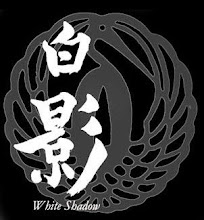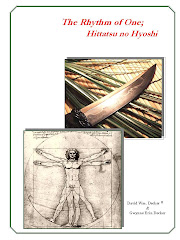“Beware the man with a thousand knives;” quipped one of my commentators. Well my collection of fighting knives does not quite number a thousand, but it is well over two or three hundred. They range is style and format from tiny to very large and include variations from most cultures and ethnicities. Unlike a projectile weapon, a knife is very intimate, and whether it has a five inch or a twelve inch blade that intimacy carries through. Yes, techniques must be altered in many small ways to accommodate the size difference, but you are still working within a combative range (ma-ai) defined in inches and feet, not hundreds of yards. Can a Bowie knife be manipulated like a karambit? The answer to that is patently clear; no of course not. But, as Musashi said in his classic text, a warrior should be able to pick up any weapon and apply it. Within a small space of time a good practitioner of Silat should be able to put up a good fight with a Bowie as well as a Golok or a Marine Corp KaBar. Illustrated here are a double-edged Bowie by Phillip Patton, a karambit by Richard Derespina, and an F/S Fighting Knife by Peter Parkinson. Knife formats don’t get much different than this unless you get into Mediterranean styles.

The toughest transitions are from a knife art that focuses on thrusting to one that concentrates on cutting, to one that relies on ripping or tearing. For years I considered the Fairbairn Sykes dagger THE ultimate fighting knife. I have collected and worked with F/S knives for many years, even designing a unique variation on it. I finally have to admit I was wrong and pass the accolade of “world’s best fighting knife” to knives in the Bowie format. People like Bill Bagwell will wonder what took me so long to figure that out. I am sure that many of my readers have similar likes or prejudices and that is what makes the world go round and also keeps knife makers in work. Within a couple weeks I should have my latest Big Bowie from Matt Lamey. It has had a long gestation period. Although I am by nature not a patient man I am confident it will be worth the wait. Pick up a Bowie of any blade size, from five inches to twelve inches and it will fundamentally handle the same. Pick up an Arkansas Toothpick of a similar size and it will not work the same as the Bowie. Select a four inch “bowie” and a similarly sized karambit and you will quickly discover you have two incompatible weapons systems which cannot be wielded in the same manner.
What is my point? When a skilled warrior picks up an edged weapon he immediately adapts to its format. He intuitively knows whether it rips, cuts, or pierces. He does not have to know barrel twist, projectile velocity, trajectory, or drop. He does not have to calculate windage or compensate for different projectile weights. The killing weapon is seated right there in his hand, flesh and steel become one. His opponent is scant feet away, not hundred of yards, and he can smell his enemies fear. This is the intimacy of edged weapons combat. The man who only knows how to use one blade size or shape has much left to learn.
 Please remember our Heroes today. Men and women, Vets and active duty, the wounded and disabled. Thousands of women and men have sacrificed much that we can live freely. This is the greatest nation on earth and its time the POTUS came out and said so instead of apologizing for our greatness. God Bless our Nation, God Bless our Troops.
Please remember our Heroes today. Men and women, Vets and active duty, the wounded and disabled. Thousands of women and men have sacrificed much that we can live freely. This is the greatest nation on earth and its time the POTUS came out and said so instead of apologizing for our greatness. God Bless our Nation, God Bless our Troops.




 The toughest transitions are from a knife art that focuses on thrusting to one that concentrates on cutting, to one that relies on ripping or tearing. For years I considered the Fairbairn Sykes dagger THE ultimate fighting knife. I have collected and worked with F/S knives for many years, even designing a unique variation on it. I finally have to admit I was wrong and pass the accolade of “world’s best fighting knife” to knives in the Bowie format. People like Bill Bagwell will wonder what took me so long to figure that out. I am sure that many of my readers have similar likes or prejudices and that is what makes the world go round and also keeps knife makers in work. Within a couple weeks I should have my latest Big Bowie from Matt Lamey. It has had a long gestation period. Although I am by nature not a patient man I am confident it will be worth the wait. Pick up a Bowie of any blade size, from five inches to twelve inches and it will fundamentally handle the same. Pick up an Arkansas Toothpick of a similar size and it will not work the same as the Bowie. Select a four inch “bowie” and a similarly sized karambit and you will quickly discover you have two incompatible weapons systems which cannot be wielded in the same manner.
The toughest transitions are from a knife art that focuses on thrusting to one that concentrates on cutting, to one that relies on ripping or tearing. For years I considered the Fairbairn Sykes dagger THE ultimate fighting knife. I have collected and worked with F/S knives for many years, even designing a unique variation on it. I finally have to admit I was wrong and pass the accolade of “world’s best fighting knife” to knives in the Bowie format. People like Bill Bagwell will wonder what took me so long to figure that out. I am sure that many of my readers have similar likes or prejudices and that is what makes the world go round and also keeps knife makers in work. Within a couple weeks I should have my latest Big Bowie from Matt Lamey. It has had a long gestation period. Although I am by nature not a patient man I am confident it will be worth the wait. Pick up a Bowie of any blade size, from five inches to twelve inches and it will fundamentally handle the same. Pick up an Arkansas Toothpick of a similar size and it will not work the same as the Bowie. Select a four inch “bowie” and a similarly sized karambit and you will quickly discover you have two incompatible weapons systems which cannot be wielded in the same manner. This hawkbill design is sure to be an awesome ripper. Only testing will tell how well it slices and thrusts. I'd like to have one in about a 6 inch blade. The Bowies I had for sale are sold but there will be more custom knives for sale in the near future as I weed out the herd. They will be sold at reasonable prices and not some crazy marked-up prices.
This hawkbill design is sure to be an awesome ripper. Only testing will tell how well it slices and thrusts. I'd like to have one in about a 6 inch blade. The Bowies I had for sale are sold but there will be more custom knives for sale in the near future as I weed out the herd. They will be sold at reasonable prices and not some crazy marked-up prices.  So take a look at Channings very neat knife and soon I will post a review of how it works out.
So take a look at Channings very neat knife and soon I will post a review of how it works out.








